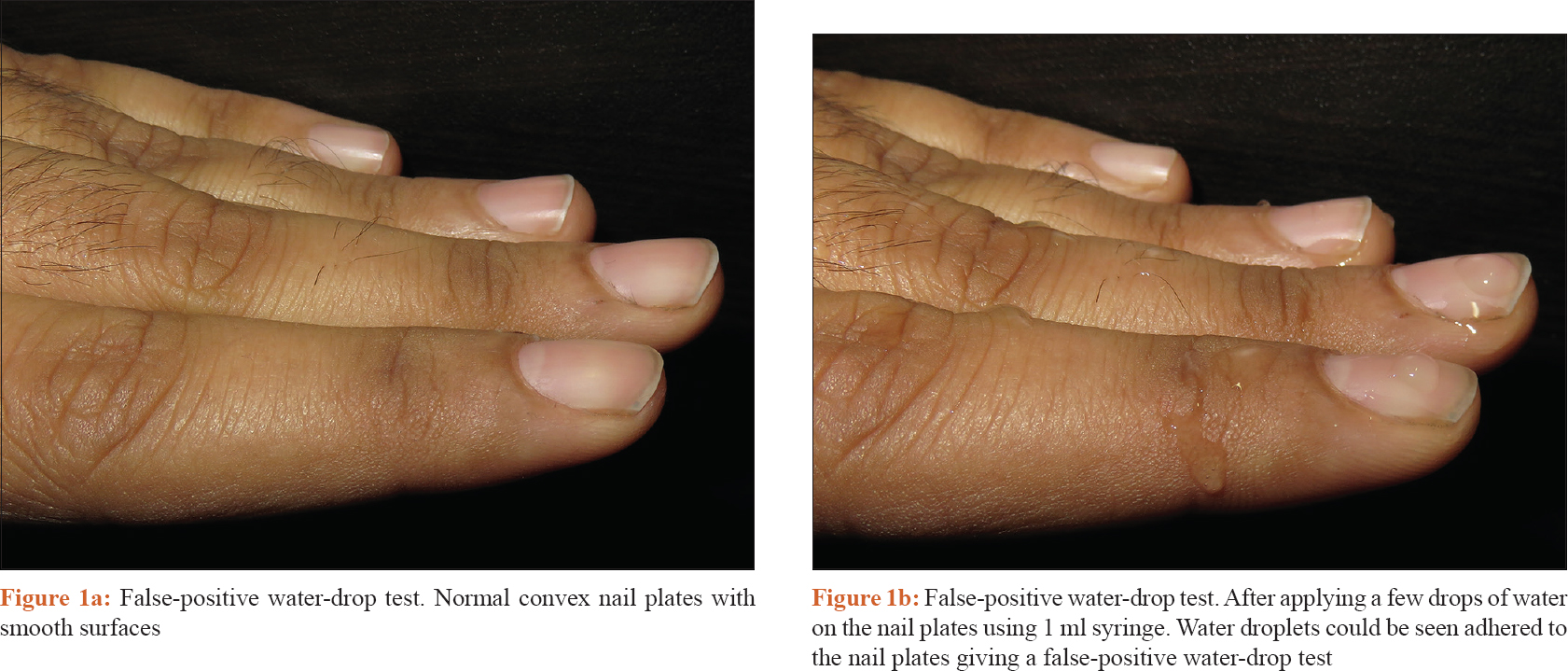Translate this page into:
Bead retention test in koilonychia
Correspondence Address:
Dipankar De
Department of Dermatology, Venereology and Leprology, Postgraduate Institute of Medical Education and Research, Sector 12, Chandigarh - 160 012
India
| How to cite this article: Razmi T M, De D. Bead retention test in koilonychia. Indian J Dermatol Venereol Leprol 2019;85:229-230 |
Problem
Koilonychia is an important clinical clue to the associated dermatoses such as psoriasis, lichen planus, alopecia areata, onychomycosis, genodermatoses, iron deficiency anemia, hypothyroidism, hyperthyroidism, diabetes mellitus and repeated occupational trauma. Unlike pitting and pterygium, koilonychia is difficult to diagnose on visual examination. Complex mathematics is required to measure nail convexity; thus, taking measurements is not practical or feasible in the clinical setting. Water-drop test is a classically described clinical test to diagnose koilonychia.[1] In this test, a few water drops are poured over the nail plate using a 1 ml syringe. In koilonychia, these droplets pool over the concave nail plates, unlike the normal convex nail plates. However, nails are highly hydrophilic.[2] Water droplets even attach to vertically placed windowpanes because of the adhesive properties of water.[3] It will be difficult to interpret whether pooling of water droplets on the hydrophilic nail plates in the water-drop test is due to this adhesive property of water or due to pooling of water on concave nail plates of koilonychia. Accordingly, sometimes, we observe false-positive water-drop test in individuals with normal smooth convex nail plates [Figure - 1]a and [Figure - 1]b.
 |
| Figure 1: |
Solution
We use easily available spherical plastic beads to rule out koilonychia. Unlike water droplets which may stick to the nail plate, these beads easily roll down from the normal convex nails. But, nail plates of koilonychia retain these beads on their concave surface. To demonstrate this, we placed spherical plastic beads on the nail plates of an iron deficiency anemia patient with associated koilonychia. The beads were retained on the nail plates and did not roll down [Figure - 2]a and [Figure - 2]b. Placing the patient's hands on a rigid, flat surface helps to counter undue hand movements. This circumvents the technical difficulty in retaining the beads on the nail surface, particularly in the setting of a clinically inapparent koilonychia [Figure - 3]a and [Figure - 3]b.
 |
| Figure 2: |
 |
| Figure 3: |
This simple test not only circumvents the false-positive interpretation regarding koilonychia but also gives an excellent visual impression to both clinicians and patients. We have demonstrated this test further in five koilonychia patients (5/5 tested positive) and five controls with normal convex nails (5/5 tested negative). Even though we did not find any false-positive or false-negative test results with this novel test, further studies are needed to validate this test in koilonychia.
Declaration of patient consent
The authors certify that they have obtained all appropriate patient consent forms. In the form the patients have given their consent for their images and other clinical information to be reported in the journal. The patients understand that their names and initials will not be published and due efforts will be made to conceal their identity, but anonymity cannot be guaranteed.
Financial support and sponsorship
Nil.
Conflicts of interest
There are no conflicts of interest.
| 1. |
Chelidze K, Lipner SR. The water-drop test for the diagnosis of koilonychia. J Am Acad Dermatol 2017;77:e157-8.
[Google Scholar]
|
| 2. |
Maloney MJ, Paquette EG, Shansky A. The physical properties of fingernails I. Apparatus for physical measurements. J Soc Cosmet Chem 1977;28:415-25.
[Google Scholar]
|
| 3. |
Adhesion and Cohesion of Water; 2017. Available from: https://www.water.usgs.gov/edu/adhesion.html. [Last accessed on 2018 Apr 21].
[Google Scholar]
|
Fulltext Views
6,924
PDF downloads
2,678





